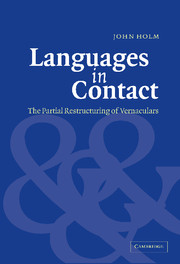1 - The study of partially restructured vernaculars
Published online by Cambridge University Press: 22 September 2009
Summary
Introduction
Language is a kind of social behavior, one of the many ways in which individuals interact with those around them. Thus linguistics is a social science, and linguists take pride in thinking of themselves as scientists, with all the objectivity that word denotes. Unfortunately, objectivity is very hard to achieve, especially in the social sciences, and linguistics is no exception. It is hard to imagine any study of language which manages to put away all ideology, but in the case of the languages discussed in this book, the task is unimaginable.
African American English – also called AAE, Ebonics, or just Black English – is a good case in point. Until at least the middle of the twentieth century, the overwhelming majority of white Americans saw their country and its culture as the product of their European roots flourishing in a new land. This ideology allowed very little room for the contribution of other cultures, so that even the distinctiveness of the folk ways and speech of African Americans was attributed to their frequent lack of access to education and general ignorance – if not to their very intelligence. Thus well into the 1950s Negro Nonstandard English (as AAE was then called) was usually considered bad English in need of eradication rather than study. In so far as its origins were considered at all, it was assumed to have descended solely from British dialects that had been left untended in America.
- Type
- Chapter
- Information
- Languages in ContactThe Partial Restructuring of Vernaculars, pp. 1 - 23Publisher: Cambridge University PressPrint publication year: 2003

